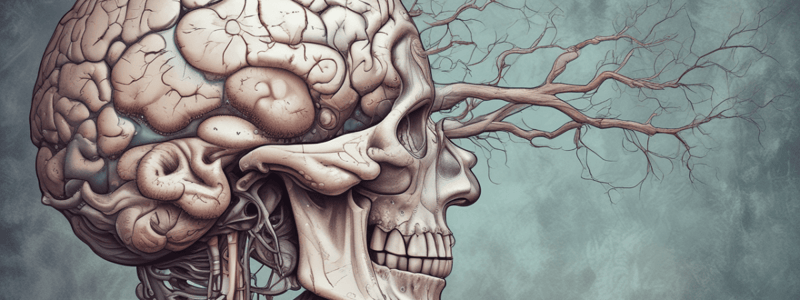Podcast
Questions and Answers
What percentage of brain tumor patients present with seizures?
What percentage of brain tumor patients present with seizures?
- 20%
- 35% (correct)
- 40%
- 50%
What is the primary treatment modality for brain tumors?
What is the primary treatment modality for brain tumors?
- Radiation therapy
- Surgery (correct)
- Chemotherapy
- CT scan
What is the typical timing of headaches in brain tumor patients?
What is the typical timing of headaches in brain tumor patients?
- Worst in the morning (correct)
- Constant throughout the day
- Worst at night
- Worst during exercise
Which type of radiation therapy is also known as 'Gamma-knife'?
Which type of radiation therapy is also known as 'Gamma-knife'?
What is a common sequela of left hemispheric tumors?
What is a common sequela of left hemispheric tumors?
What is the most common primary brain tumor?
What is the most common primary brain tumor?
What is the most common malignant primary brain tumor?
What is the most common malignant primary brain tumor?
What is the most common brain tumor overall?
What is the most common brain tumor overall?
What is the occupation that is associated with an increased risk of developing primary CNS tumors?
What is the occupation that is associated with an increased risk of developing primary CNS tumors?
What is the type of radiation that is associated with an increased risk of developing primary CNS tumors?
What is the type of radiation that is associated with an increased risk of developing primary CNS tumors?
What is the genetic predisposition that is associated with an increased risk of developing primary CNS tumors?
What is the genetic predisposition that is associated with an increased risk of developing primary CNS tumors?
What is the cancer that is most likely to metastasize to the brain?
What is the cancer that is most likely to metastasize to the brain?
What is the characteristic of meningioma?
What is the characteristic of meningioma?
What is the characteristic of acoustic neuroma?
What is the characteristic of acoustic neuroma?
What is the characteristic of glioblastoma?
What is the characteristic of glioblastoma?
Flashcards are hidden until you start studying
Study Notes
Primary CNS Tumors
- Primary CNS tumors originate in the brain or spinal cord, whereas secondary CNS tumors metastasize from cancers in other organs.
- Most common primary brain tumor is meningioma, while most common malignant primary brain tumor is glioblastoma.
- Most common brain tumor overall is metastatic cancer from another source.
Risk Factors
- Occupation: white collar professionals, healthcare, and lab research.
- Exposure to ionizing radiation, therapeutic radiation therapy, and history of head trauma.
- Environmental exposure to N-nitroso compounds, genetic predisposition (neurofibromatosis types 1 & 2), and radiofrequency radiation and electromagnetic radiation exposure.
Metastatic Intracranial Tumors
- Cancer originates elsewhere in the body and metastasizes to the brain via blood.
- Most common brain tumors in adults, with 4-10 times more frequent occurrence than primary brain tumors.
- Usually multiple lesions, with cancers most likely to spread to the brain being lung, breast, melanoma, renal cell, and colon.
Classification of Primary Brain Tumors
Meningioma
- Attached to the dura mater, slow-growing tumors with a strong female predominance.
- Consider neurofibromatosis, often asymptomatic, with surgery as the main treatment.
- Problems arise from pressure, with visual complications if affecting optic nerve tract, and seizures in 25-40% of patients.
Acoustic Neuroma
- Also known as vestibular schwannoma, arising from the vestibular portion of CN VIII.
- Median age at diagnosis is 50, with unilateral cases in more than 90% of cases.
- Bilateral vestibular schwannomas suggest neurofibromatosis type 2 until proven otherwise.
- Risk factors include familial or genetic risk, noise exposure, and leisure settings (OR=1.9) and work (OR=1.5).
- Clinical presentation includes asymmetric sensorineural hearing loss with or without other focal cranial nerve deficits, confirmed with audiometry and imaged with MRI or CT.
Glioblastoma
- Most common primary malignant brain tumor, with usual age-of-onset above 60.
- Usually located in cerebral white matter, with heterogeneous cellular origins.
- Characterized by necrosis with vascular proliferation, forming a "ring of tissue around necrotic core".
Glioma
- Catch-all term for tumors originating from glial cells (neural structural/support cells).
- Includes astrocytoma, glioblastoma, and oligodendroglioma.
- Graded by the presence or absence of standard pathologic features (WHO Grades I-IV).
Clinical Presentation of Brain Tumors
- Headaches in 20% of cases, typically worst on rising in the morning.
- Seizures in 35% of cases, with presentation depending on location.
- Can mimic stroke, with clinical features evaluated through CT and/or MRI, EEG, surgery, and radiation therapy.
Sequelae of Brain Tumors
- Cognitive dysfunction, frontal personality, and loss of social inhibition.
- Left hemispheric tumors: language dysfunction.
- Right hemispheric tumors: problems with visual perception and scanning.
Studying That Suits You
Use AI to generate personalized quizzes and flashcards to suit your learning preferences.




